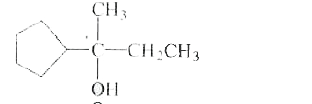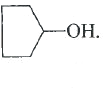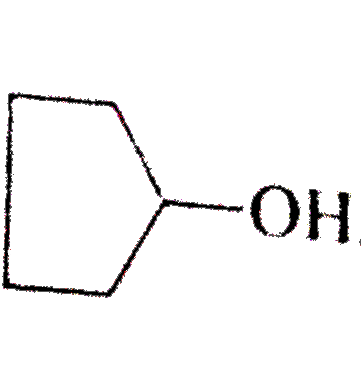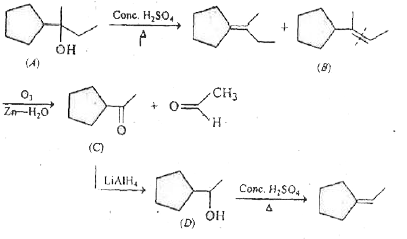A optically active alcohol 'A' on dehydration with conc. produces which exists in two stereoisomeric forms. For ozonolysis of B followed by work up with produces . C on treatment with produces . D on dehydration produced  Identify the correct answer.
Identify the correct answer.
A is 
A is 
D is 
D is 
The correct Answer is:B, D
Similar Questions
Knowledge Check
A 3∘ optically active alcohol C9H18O 'A' on dehydration with conc. H2SO4 produces B(C9H16) which exists in two stereoisomeric forms. For ozonolysis of B followed by work up with Zn−H2O produces CH3−C∣∣O−HandC(C7H12O. C on treatment with LiAlH4 produces D(C7H14O). D on hehydration produced

Identify the correct the correct answers.A B
B C
C D
D
H3C−CH2−C∣∣O−CH3NaBH4−−−−→D2O Product ?
AH3C−OD∣C∣H−CH2−CH3BH3C−OHC∣∣D−CH2−CH3CH3C−OD∣C∣D−CH2−CH3DnoneH3C−O−CH2−Cl H3C−C∣∣O−CH2−Cl H3C−CH2−Cl H3C−Cl
AQ>P>S>RBP>Q>R>SCS>R>P>QDS>R>Q>P
An optically active alcohol A (C8H16O) on oxidation gives B. A on heating gives C (C8H14) as major product. C on ozonolysis produces D (C5H8O)andCH3−C∣∣O−CH3. D on reduction with LiAlH4 gave
 . Identify correct answer.
. Identify correct answer.
View SolutionAn optically active alcohol A (c8H16O) on oxidation gives B. A on heating gives C(C8H14) as major product. C on ozonlysis produces D(C5H8O) and CH3−C∣∣O−CH3. D on reduction with LiAlH4 gave
 . Identify correct answers.
. Identify correct answers.
View SolutionAn optically active alcohol A(C8H16O) on oxidation gives B. A on acidic heating gives C(C8H14) as major product. C on ozonolysis produces D(C5H8O) and H3−C∣∣O−CH3. D on reduction with LiAIH4 gave

Identify correct answer
View SolutionA neutral organic compound A(C5H8O2) does not decolorize Bayer.s reagent and on hydrolysis with dilute H2SO4 produces B(C2H10O3), which is diastereomeric. B on heating with concentrated H2SO4 undergoes dehydration producing C(C5H8O2), which shows geometrical isomerism. Also B on treatment with acidic dichromate solution produced D(C5H8O2), which is enantiomeric and gives a yellow precipitate with NaOI. D on gentle heating produces E (C4H8O),which is non-resolvable.
Compound (C) is
View SolutionA neutral organic compound A(C5H8O2) does not decolorize Bayer.s reagent and on hydrolysis with dilute H2SO4 produces B(C2H10O3), which is diastereomeric. B on heating with concentrated H2SO4 undergoes dehydration producing C(C5H8O2), which shows geometrical isomerism. Also B on treatment with acidic dichromate solution produced D(C5H8O2), which is enantiomeric and gives a yellow precipitate with NaOI. D on gentle heating produces E (C4H8O),which is non-resolvable.
Compound (B) is
View Solution

